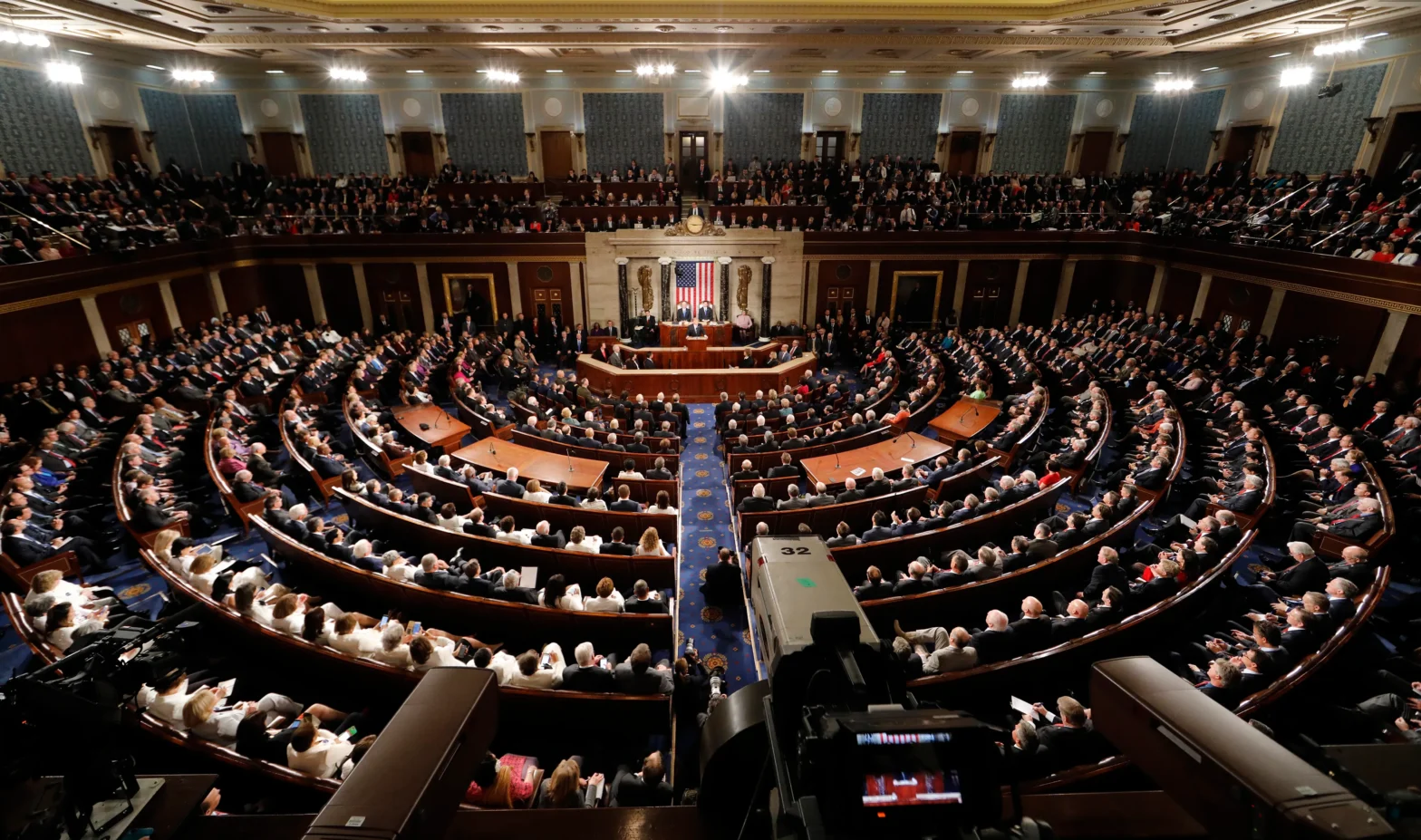The United States Congress, the legislative arm of the federal government, is a bicameral body composed of two chambers: the Senate and the House of Representatives. This dual-chamber system, established by the Constitution, balances the representation of states and the populace, ensuring a robust and thorough legislative process. Each chamber has distinct roles, responsibilities, and structures that collectively facilitate the functioning of the federal government.
The Senate consists of 100 members, with each state represented by two senators, regardless of its population size. Senators serve six-year terms, with approximately one-third of the Senate seats up for election every two years. This structure allows the Senate to act as a stabilising force, providing continuity and a longer-term perspective on legislative issues.
The House of Representatives, on the other hand, is composed of 435 members, with representation based on each state’s population. House members serve two-year terms, making them more immediately responsive to the electorate’s changing preferences. This chamber is designed to reflect the will of the people more directly and frequently, ensuring that the legislative body remains aligned with public opinion.
The legislative process in Congress is complex and involves several stages designed to scrutinise and refine proposed legislation. A bill can be introduced in either chamber, except for revenue bills, which must originate in the House of Representatives. Once introduced, a bill is assigned to a relevant committee for detailed examination and debate.
Committees and subcommittees play a crucial role in shaping legislation. They conduct hearings, gather evidence, and make necessary amendments to the proposed bills. If a committee approves a bill, it is sent to the full chamber for debate and voting. Both the House and the Senate must pass identical versions of the bill for it to proceed to the President, who can then sign it into law or veto it.
Committees and subcommittees are the backbone of Congress, enabling it to manage the vast array of issues it addresses. Each committee focuses on specific areas, such as finance, defence, or health. Subcommittees allow for even more specialised scrutiny, ensuring that every aspect of a bill is carefully considered.
Key committees include the House Ways and Means Committee, which oversees taxation and revenue-related matters, and the Senate Judiciary Committee, which handles issues related to the legal system and judicial appointments. The work done in these committees is critical to the legislative process, as they are the primary venues for detailed policy discussions and negotiations.
One of Congress’s essential functions is to provide checks and balances on the executive branch. This oversight is conducted through various means, including investigations, hearings, and the power of the purse. Committees such as the House Oversight and Reform Committee and the Senate Homeland Security and Governmental Affairs Committee are instrumental in this role.
Congress can investigate executive actions and demand accountability from federal agencies and officials. This oversight ensures that the executive branch operates within the law and uses its powers appropriately. Additionally, Congress controls federal spending, which it can use to influence executive priorities and programs.
The relationship between Congress and the President can be collaborative or contentious, depending on the political context. When the same party controls both the executive and legislative branches, collaboration on legislative agendas is typically smoother. However, when different parties control the branches, conflicts often arise, leading to legislative gridlock.
A significant example of this dynamic is the budgeting process. The President proposes a budget, but Congress must approve it. Disagreements between the President and Congress on budgetary priorities can lead to government shutdowns, as seen in recent years. These shutdowns occur when Congress and the President cannot agree on funding levels and appropriations, highlighting the tension that can exist between the branches.
In recent years, Congress has grappled with several significant legislative issues, reflecting the nation’s diverse and often polarised political landscape. Among these issues are healthcare reform, immigration policy, infrastructure investment, and climate change. Each of these topics reveals the intricate dynamics of bipartisanship and partisanship within Congress.
Healthcare reform has been a contentious issue, particularly in the wake of the Affordable Care Act (ACA). Republicans have sought to repeal or replace the ACA, citing concerns about government overreach and costs, while Democrats have defended and sought to expand it, emphasising the need for universal healthcare access. This debate underscores the partisan divide on fundamental policy approaches and the challenges of achieving consensus.
Immigration policy is another area where partisanship is pronounced. The debate over border security, pathways to citizenship for undocumented immigrants, and the treatment of asylum seekers has led to sharp divisions. Efforts to pass comprehensive immigration reform have repeatedly stalled, illustrating the difficulty of reconciling divergent views on a complex and sensitive issue.
Infrastructure investment, despite its generally bipartisan appeal, has also faced hurdles. While there is broad agreement on the need to modernise and repair the nation’s infrastructure, disagreements over funding mechanisms and priorities have delayed significant legislative action. The recent passage of the Infrastructure Investment and Jobs Act, however, marked a rare instance of bipartisan cooperation, highlighting that compromise is possible even in a polarised environment.
Climate change legislation exemplifies the ideological rift between parties. Democrats have pushed for aggressive action to reduce carbon emissions and transition to renewable energy, while many Republicans have resisted measures they view as economically disruptive. The debate over climate policy reflects broader ideological differences on the role of government regulation and market-based solutions.
The dynamics of bipartisanship and partisanship in Congress are shaped by various factors, including ideological differences, electoral pressures, and the influence of interest groups. While partisanship often leads to gridlock, moments of bipartisanship demonstrate the potential for cooperation and compromise. Achieving bipartisan support typically requires negotiation, concessions, and a willingness to find common ground on shared goals.
The US Congress, with its dual chambers and complex legislative process, plays a pivotal role in the functioning of the federal government. Its structure, comprising the Senate and the House of Representatives, ensures a balance between state and popular representation. Through committees and subcommittees, Congress meticulously examines legislation and exercises oversight over the executive branch, maintaining the system of checks and balances essential to American democracy.
Current legislative issues, marked by both partisan divides and occasional bipartisan efforts, reflect the dynamic nature of Congress. The institution’s ability to navigate these challenges and fulfil its legislative and oversight responsibilities remains crucial to addressing the nation’s needs and advancing the public interest. As Congress continues to evolve, its capacity for collaboration and its role in checking executive power will remain central to the health and stability of the United States’ democratic system.






















